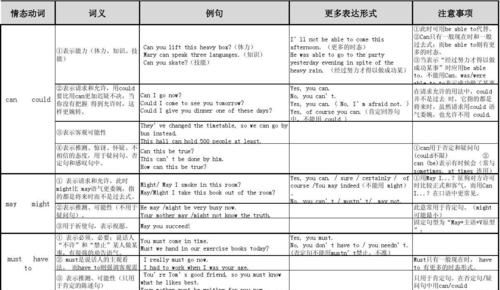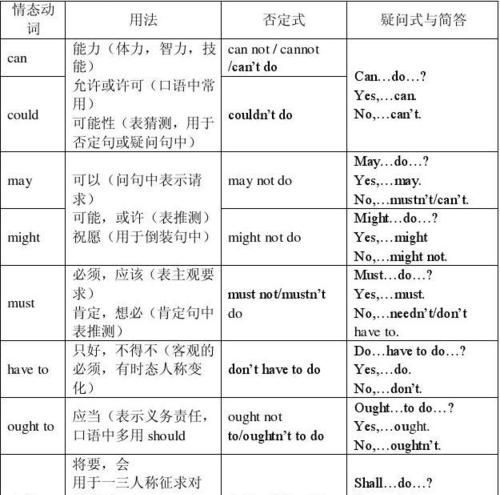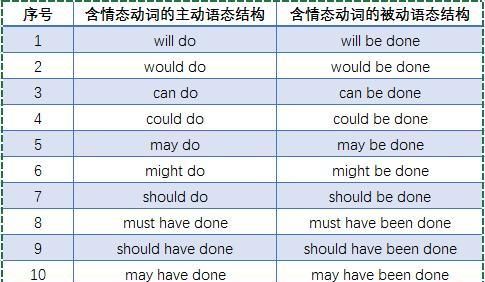本文目录
情态动词在用法上怎么辨别
情态动词不能单独作谓语, 只能和其他动词原形构成谓语。 情态动词主要有下列: can (could), may (might), must, need, ought to, dare (dared), shall (should), will (would) . 情态动词在句中放在谓语动词之前, 谓语动词前若有助动词,则在助动词之前,疑问句中, 情态动词则在主语之前。 情态动词无人称和数的变化, 情态动词后面跟的动词需用原形,否定式构成是在情态动词后面加 "not"。
你可以买一个专门的语法书。网采纳

英语中情态动词如何区分 最好的方法和时态
分三类1.常规用法,所有的都可以用,can,could,表示能力,可以,能够,could的语气弱,must必须一定偏要,shall征求对方意见,表警告或用于法律规定,should同上,语气弱,may表请求,might同上,语气弱;should表义务,应该,和疑问词连用表惊讶、愤怒、疑惑,ought to同上,语气强;will表意愿或征求意见提出请求,“执意或决心”,would同上,语气轻;need和dare半情态动词,肯定句中+to do,否定句中还可用need\dare+do
2、用于表猜测(5个)can和could用于否定句,could语气弱,must>may>might,用于肯定句
3、虚拟语气中,ought to,should,could,needn't,may,might可用

情态动词有哪些英语单词
情态动词两要点;动词原形跟后面,说话语气较委婉,can表"能力"may"许可",must"责任"或"义务",否定回答"needn't"换;should"应该",would"愿",have
to
"被迫"表客观.
注释:对must构成的一般疑问句作否定回答只能用needn't.
can的用法
1.
表能力
can
your
sister
skate
/
can
you
sing
/
can
you
dance
2.
表示可能性
can
you
go
with
us
we
can
go
there
by
bus.
3.
表示同意做某事,意为"允许","可以"
you
can
go
now.
can
i
have
a
look
at
your
photos
4.
表推测(主要用于否定句,疑问句)
it
can't
be
jay
zhou.
he
can't
be
thinking
about
something.
must的用法
1.
表示按命令,规定,责任等必须要做的事.
you
must
do
all
the
homework
by
yourself.
you
mustn't
park
your
car
here.
在回答由must引导的一般疑问句时,如果表示肯定,用must;如果表示否定,要用needn't.
-must
i
come
here
tomorrow
-yes,
you
must.
(no,
you
needn't.)
2.
表示肯定的推测,意为"一定会","一定是",多用于肯定句.
it
must
belong
to
karla.
he
must
be
happy.
you
must
be
joking.
must和have
to
的区别是:must表示说话人的主观意愿,而have
to
则表示客观要求,意为"不得不".
you
must
tell
us
what
you
have
seen.
he
had
to
walk
home
because
the
bus
had
left.
need的用法
need除了可用作行为动词外,还可用作情态动词,作为情态动词使用时,多用于疑问句和否定句,后面直接跟动词原形,作为行为动词时,后面跟带to的动词不定式.
他需要现在去看医生吗
does
he
need
to
see
a
doctor
now
need
he
see
a
doctor
now
need作为情态动词,意为"需要",无时态和人称的变化.
they
needn't
hand
in
their
homework
now.
need
i
stay
with
you
(肯定回答为:yes,
you
must.
否定回答用no,
you
needn't.)
may的用法
1.
表示"可以",用以询问或说明可否做某事.
may
i
use
your
pencil
you
may
come
here
tomorrow.
(在回答由may引导的问题时,常以yes,
please或certainly来表示允许或同意,而用please
don't
或no,
you
mustn't来表示不允许和反对.)
2.
用于表推测某事可能发生或某情况可能存在,意为"可能",一般不用于疑问句.
it
may
rain
this
afternoon.
she
may
still
be
in
the
classroom.
注:①只做情态动词:must,can(could),may(might),
②可做情态动词又可做实义动词:need,dare
③可做情态动词又可做助动词:shall(should),will(would)
,ought
to
④具有情态动词特征:have(had,has)
to,used
to
⑤情态动词表猜测

如何辨别情态动词
和动词连用,表明说话者(或主语)情绪或态度的动词为助动词.常见的情态动词有:will would won't wouldn'tshall should shan't shouldn'tcan could can't couldn'tmay mightmust mustn'thave toused toought toneed ...

以上就是关于情态动词怎么区分 ,情态动词在用法上怎么辨别的全部内容,以及情态动词怎么区分 的相关内容,希望能够帮到您。
